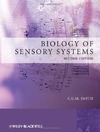Since publication of the first edition, huge developments have taken place in sensory biology research and new insights have been provided in particular by molecular biology. These show the similarities in the molecular architecture and in the physiology of sensory cells across species and across sensory modality and often indicate a common ancestry dating back over half a billion years.
Biology of Sensory Systems has thus been completely revised and takes a molecular, evolutionary and comparative approach, providing an overview of sensory systems in vertebrates, invertebrates and prokaryotes, with a strong focus on human senses.
Written by a renowned author with extensive teaching experience, the book covers, in six parts, the general features of sensory systems, the mechanosenses, the chemosenses, the senses which detect electromagnetic radiation, other sensory systems including pain, thermosensitivity and some of the minority senses and, finally, provides an outline and discussion of philosophical implications.
New in this edition:
Over four hundred illustrations, boxes containing supplementary material and self-assessment questions and a full bibliography at the end of each part make Biology of Sensory Systems essential reading for undergraduate students of biology, zoology, animal physiology, neuroscience, anatomy and physiological psychology. The book is also suitable for postgraduate students in more specialised courses such as vision sciences, optometry, neurophysiology, neuropathology, developmental biology.
Praise from the reviews of the first edition: ''An excellent advanced undergraduate/postgraduate textbook.'' ASLIB BOOK GUIDE ''The emphasis on comparative biology and evolution is one of the distinguishing features of this self-contained book. .... this is an informative and thought-provoking text...'' TIMES HIGHER EDUCATIONAL SUPPLEMENT
 |
|
О проекте
|
|
О проекте


